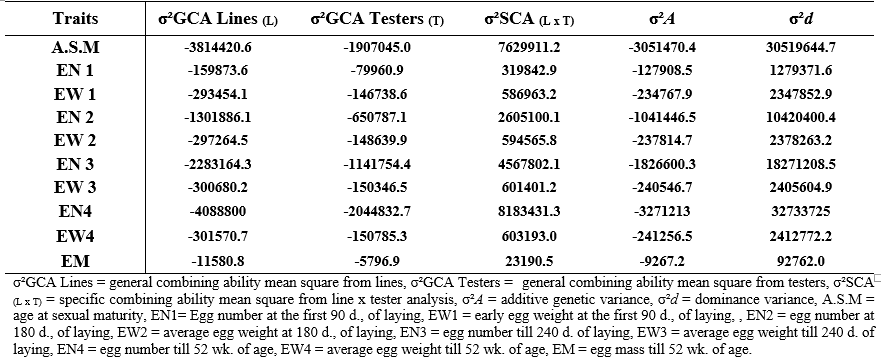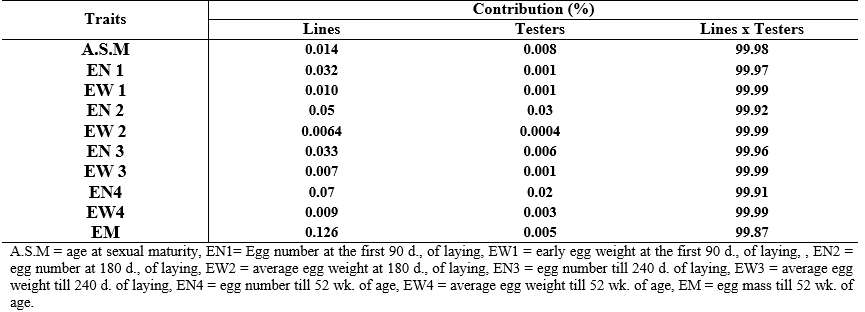Using Tester in Poultry Breeding
Published: April 15, 2014
By: Abou El-Ghar, R.Sh.
INTRODUCTION:
Many studies of the effect of inbreeding and/or outbreeding in plant and animal population to know whether it will be better to develop lines or hybrids. It is necessary to know the mean and variance of all varieties of a give type which can be derived from the breeding population. Crossing is an effective tool for genetic improvement of quantitative characters in the fowl, and it may be useful in detecting good lines which possibly exploit heterosis during hybridization, and may evolve more favorable genes to their progenies. A numerical application suggested that the single crosses (line x tester) will be better than the best lines. Tester is common to be inbred or outbreed lines even single cross tester, which is considered a rabid method for developing the best 3-way and/or double cross combination. Oldemeyer et al., (1968) stated that good tester varieties must be chosen with of different origin than the material being tested, relatively broad genetic base and inherently poor in performance. The concept of combining ability is especially useful in testing the ability of parents to attain high performance when crossed with different testers. One of the methods used to estimate the variance components and effects due to general and specific combining ability is line x tester mating design (Kempthorne, 1957). General combining ability was found to be important for almost all traits (Fairfull et al., 1983; Singh et al., 1983 and Gupta et al., 2000 and Szydlowski and Szwaczkowski 2001). However, specific combining ability was more widely important than has been reported elsewhere (Fairfull and Gowe, 1990; Wei et al., 1991 a,b; Wei and van der Werf, 1993; Abou El-Ghar et al., 2003 and Abou El-Ghar and Abdou, 2004). The current study aimed to estimate the combining ability effects, to estimates the additive and dominance mean squares and to estimate the contribution of various genetic variance components to the total variance for egg production yield by using line x tester analysis; these estimates would provide guidelines to the fowl breeders to launch effective breeding strategies.
THE METHODOLOGY:
Progenies of eight F1 hybrids developed from line x tester mating design by crossing four local developed strains, used as male (Lines) they include: Baheij, Matrouh, Silver Montazah and Golden Montazah chickens together with females of two genetic stocks of commercial laying hens (Testers) i.e. Lohman Brown and Lohman Selected Leghorn. The crossing plan of this experimentwas each line crossed to each of the two testers thus we have 8 crosses, along with 6 parents, i.e., 4 lines and 2 testers. The observations were recorded on 1195 hens (595 lines, 200 testers and 400 lines x testers hybrids) and tested in a Randomized Complete Block Design with 5 replicates for providing information about the general combining ability of a line and specific combining ability in hybrid combinations. Ten egg production traits were studied; i.e. Age at sexual maturity, number of eggs at 1st 90 d of laying, average egg weight through the 1st 90 d of laying, number of eggs at 180 d of laying, average egg weight at 180 d of laying, number of eggs at 240 d of laying, average egg weight at 240 d of laying, number of eggs at 52 wks of laying, average egg weight at 52 wks of laying and egg mass throughout 52 wks of laying.
RESULTS:
The magnitude of specific combining ability variance was evident from mean squares indicating that egg production traits had been controlled by non-additive genes. However, among the four male lines, Silver Montazah showed maximum general combining ability effects for number of eggs at 90 d of laying, number of eggs at 180 d of laying, number of eggs at 240 d of laying, number of eggs till 52 wks of laying, average egg weight at 52 wks of laying and egg mass throughout 52 wks of laying traits. The second high general combining ability scoring parent for the previous traits was Golden Montazah parental line. While the male lines Golden Montazah and Matrouh were good general combiners for age at sexual maturity -34.3 and -30.0, respectively. Moreover, Golden Montazah parental line was the best general combiner for average egg weight through the 1st 90 d of lying, average egg weight at 180 d of lying and average egg weight at 240 d of laying traits. Regarding the experimental testers, Lohman Selected Leghorn represented higher estimates of general combining ability effects for age at sexual maturity, number of eggs at 180 d of laying, number of eggs at 240 d of laying and number of eggs till 52 wks of laying, average egg weight at 52 wks of laying, while Lohman Brown tester represented higher estimates of general combining ability for egg weight through the 1st 90 d of laying, average egg weight at 180 d of lying, average egg weight at 240 d of laying and average egg weight at 52 wks of laying. The general combining ability and specific combining ability variances estimates suggested that all the studied traits could be improved through hybridization. However, the hybrids Silver Montazah x Lohman Brown and Baheij x Lohman Selected Leghorn exhibited maximum specific combining ability effect for annual egg production. Consequently, the priority should be given to parents Silver Montazah and Baheij lines and Lohman Brown and Lohman Selected Leghorn testers for improving egg production yield.
Table (1): Means and S.E of some egg production traits from line x tester analysis in laying hens
Table (2) General combining ability effects (GCA) of lines and testers for some egg production traits
Table (3): Specific combining ability (SCA) estimates for some egg production traits from line x tester analysis
Table (6): General combining ability variances (σ²GCA) from lines and testers, specific combining ability variance (σ²SCA) from line x tester, additive (σ²A) and dominance (σ²d) mean squares for some egg production traits
Table (7) Contribution of lines, testers, and lines x testers mean squares to the total variance for some egg production traits
REFRENCES
Abou El-Ghar, R.Sh. and F.H. Abdou, 2004.Evaluation of genetic variance components based on the concept of generation means for some economic traits in chickens. Egypt. Poult. Sci. 24:687-699.
Abou El-Ghar, R.Sh.; F.H. Abdou; G.M. Gebriel; A.A. Enab and T.H. Mahmoud, 2003. Combining ability and genetic gain of some economic traits in Norfa chickens. Egypt. Poult. Sci. 23:687-704.
Fairfull, R. W., and R. S. Gowe., 1990.In: R. D. Crawford (Ed.) Poultry Breeding and Genetics. p 705. Elsevier, Amsterdam, The Netherlands.
Fairfull, R.W.; R.S. Gowe and A.B. Emsley, 1983. Diallel cross of six long-term selected Leghorn strains with emphasis on heterosis and reciprocal effects. Br. Poult. Sci. 24:133-158.
Gupta, R.D., Khan, A.G. and Shrikant Joshi (2000). Combining ability analysis for egg production and egg weight in weight in progenies of a 3x3 diallel cross of white Leghorn. Indian Vet. J., March, 77: 223-226.
Kempthorne, O. 1957.An Introduction to Genetic Statistics. John Wiley and Sons, New York, U.S.A. pp. 191-200.
Oldemeyer, R.K.; W.H. Davis; H.L. Bush and A.W. Erichsen, 1968. The evaluation of and the use of the Top-Cross test as a method of selecting inbred lines of sugarbeets for general combining ability. Journal of the A.S.S.B.T., Vol:15, No.1.
Singh, Y. P., Singh, R. V., Chandary, R. P. and Vikram Singh (1983). Diallel crossing for estimation of G. C. A., S. C. A., heterosis and other genetic effects for various economic traits in White Leghorn. Indian Vet. J., 60:384- 389.
Szydlowski M. and T. Szwaczkowski, 2001. Bayesian segregation analysis of production traits in two strains of laying chickens. Poultry Science 80: 125-131.
Wei, M. and J.H., van der Werf, 1993. Animal model estimation of additive and dominance variances in egg production traits of poultry. J Anim Sci. 71:57-65.
Wei, M.; H.A.M. van der Steen; J.H.J. van der Werf and E.W. Brascamp, 1991a.Relationship between purebred and crossbred parameters. I. Variances and Covariances under the one-locus model. J. Anim. Breed. Genet. 108:253.
Wei, M.; J.H.J. van der Werf and E. W. Brascamp, 1991b.Relationship between purebred and crossbred parameters 11. Genetic correlation between purebred and crossbred performance under the model with two loci. J. Anim. Breed. Genet. 108:262.
Related topics:
Authors:
Recommend
Comment
Share

Would you like to discuss another topic? Create a new post to engage with experts in the community.













.jpg&w=3840&q=75)